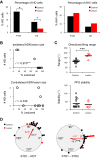Functional and anatomical relationships between the medial precentral cortex, dorsal striatum, and head direction cell circuitry. I. Recording studies
- PMID: 30427767
- PMCID: PMC6397396
- DOI: 10.1152/jn.00143.2018
Functional and anatomical relationships between the medial precentral cortex, dorsal striatum, and head direction cell circuitry. I. Recording studies
Abstract
Head direction (HD) cells fire as a function of the animal's directional heading and provide the animal with a sense of direction. In rodents, these neurons are located primarily within the limbic system, but small populations of HD cells are found in two extralimbic areas: the medial precentral cortex (PrCM) and dorsal striatum (DS). HD cell activity in these structures could be driven by output from the limbic HD circuit or generated intrinsically. We examined these possibilities by recording the activity of PrCM and DS neurons in control rats and in rats with anterodorsal thalamic nucleus (ADN) lesions, a manipulation that disrupts the limbic HD signal. HD cells in the PrCM and DS of control animals displayed characteristics similar to those of limbic HD cells, and these extralimbic HD signals were eliminated in animals with complete ADN lesions, suggesting that the PrCM and DS HD signals are conveyed from the limbic HD circuit. Angular head velocity cells recorded in the PrCM and DS were unaffected by ADN lesions. Next, we determined if the PrCM and DS convey necessary self-motion signals to the limbic HD circuit. Limbic HD cell activity recorded in the ADN remained intact following combined lesions of the PrCM and DS. Collectively, these experiments reveal a unidirectional functional relationship between the limbic HD circuit and the PrCM and DS; the limbic system generates the HD signal and transmits it to the PrCM and DS, but these extralimbic areas do not provide critical input or feedback to limbic HD cells. NEW & NOTEWORTHY Head direction (HD) cells have been extensively studied within the limbic system. The lesion and recording experiments reported here examined two relatively understudied populations of HD cells located outside of the canonical limbic HD circuit in the medial precentral cortex and dorsal striatum. We found that HD cell activity in these two extralimbic areas is driven by output from the limbic HD circuit, revealing that HD cell circuitry functionally extends beyond the limbic system.
Keywords: angular head velocity cell; anterodorsal thalamic nucleus; dorsal striatum; head direction cell; medial precentral cortex; navigation; spatial cognition.
Conflict of interest statement
No conflicts of interest, financial or otherwise, are declared by the authors.
Figures









References
-
- Batschelet E. Circular Statistics in Biology. New York: Academic, 1981.
Publication types
MeSH terms
Grants and funding
LinkOut - more resources
Full Text Sources
Miscellaneous

